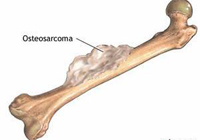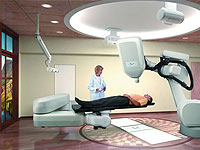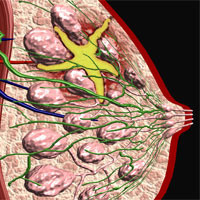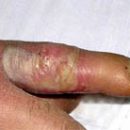Teratoma - a tumor is not simple, it does not arise anywhere, but has its typical places «habitat» and they are not so small. Where we grow teratomas and what features their appearance is characterized in a particular place - you can read in our article.
Content
Theratomas have a certain, typical localization (placement location): ovaries and testicles, sacrochitsky area, mediastinum, retroperitoneal space, zev, skull base. Adults most often found theratomas of sex glands and mediastinum. The most common localization with teratom in children is a sacker.
 The sacrum-coccular teratoma is usually detected from birth, and fruits occur, more often in girls. Most teratom of this localization benign. They sometimes reach very large size and then make it difficult to give birth. Can fill the cavity of the small pelvis, without damaging the bones of the pelvis. The tumor consists of structures resembling organs, and a variety of fabrics, for example intestinal loops, liver tissues, rudiments (increments) of the limbs, etc. Less often meet malignant teratomas (thermosoblastomes), when, along with mature tissues, the growth of carcinoma-like solid or papillary structures prevails. Papillary growths are derivatives of extraambrium tissues (trophoblast).
The sacrum-coccular teratoma is usually detected from birth, and fruits occur, more often in girls. Most teratom of this localization benign. They sometimes reach very large size and then make it difficult to give birth. Can fill the cavity of the small pelvis, without damaging the bones of the pelvis. The tumor consists of structures resembling organs, and a variety of fabrics, for example intestinal loops, liver tissues, rudiments (increments) of the limbs, etc. Less often meet malignant teratomas (thermosoblastomes), when, along with mature tissues, the growth of carcinoma-like solid or papillary structures prevails. Papillary growths are derivatives of extraambrium tissues (trophoblast).
From the tertol of ovaries in children, compared with adults, malignant theratoblasts are more common than benign dermoid cysts. They have the nature of the multi-chamber cyst consisting of mature tissues, between which there are fields of solid growing, embryonic and extra-immabrional character. Such teratoblastomes can give metastasis in the lungs. Children may have cases of mature terators consisting of fabrics that are given during operational removal, however, the interconnection of the peritoneous.
Terators of the testicles are more common in children under the age of 2 years, often detected from birth. Theratomas of the testicles in the opposite of the teratoms of the ovaries in children are more often benign. In adults, on the contrary, they are more often malignant. Malignant teratomas are more often consisting of epithelial tissue derivatives - flat ornamental epithelium, mucous glands, epithelial tissue.
Tracky and mesenterical terates in most cases manifest themselves from birth or age 2-3 years. They reach a large size, more often found in girls. Located closer to the diaphragm than to the pelvic region, as a rule, benign, are very rarely malignant.
Large polycystic and solid teratomas with the presence of immature fabrics are always malignant.
Theratomas of Growing (congenital Polyps of Sev) are polypovoid formations found in fruits and newborns. Located in the region of the upper dome of the pharynx, from where they grow in the form of polypovoid growths, one part of which is covered with mucous membrane, the other skin. Sometimes they achieve significant size and then it makes it difficult to give birth. As a rule, they consist of mature fabrics and rudimentary (infardant) organs. Sometimes there are forms corresponding to the defective second twin reaching the size of the child's head; The tumor is attached in the area of the jaws or zea (the so-called EPIGNATUS). Malignant terators of this area are rare.
Intracranial teratomas in half cases are malignant, contain embryonic growing fabrics. In rare cases, such teratomas give metastases into the lungs, they are located in the field of the base of the skull. Meet these teratoms more often in fruit and newborn. Boys are often localized near the sishkovoid gland and may be accompanied by endocrine disorders in the form of premature puberty.









